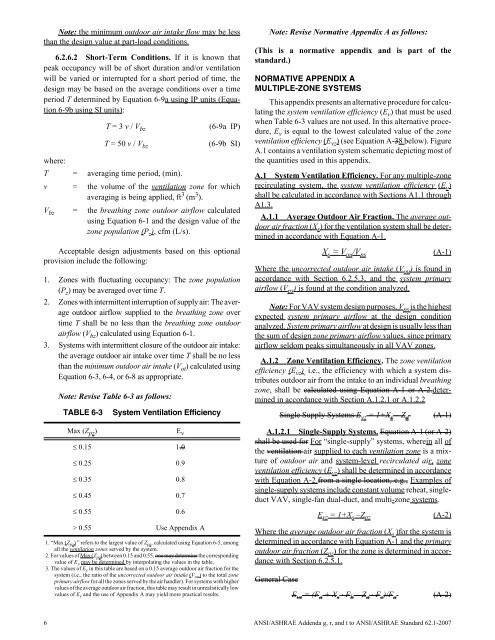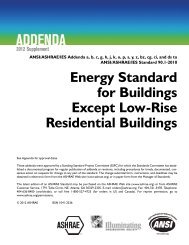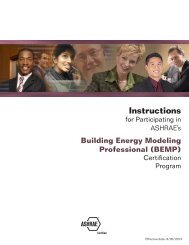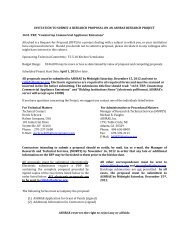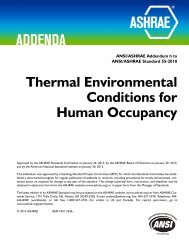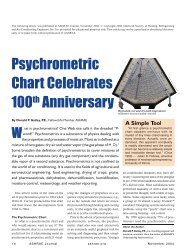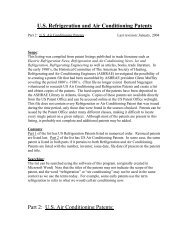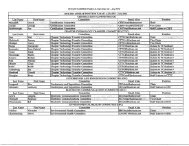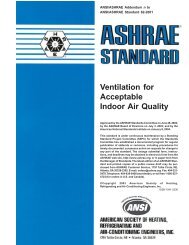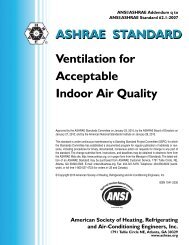ANSI/ASHRAE Standard 62.1-2007 ASHRAE STANDARD Ventilation
ANSI/ASHRAE Standard 62.1-2007 ASHRAE STANDARD Ventilation
ANSI/ASHRAE Standard 62.1-2007 ASHRAE STANDARD Ventilation
Create successful ePaper yourself
Turn your PDF publications into a flip-book with our unique Google optimized e-Paper software.
Note: the minimum outdoor air intake flow may be less<br />
than the design value at part-load conditions.<br />
6.2.6.2 Short-Term Conditions. If it is known that<br />
peak occupancy will be of short duration and/or ventilation<br />
will be varied or interrupted for a short period of time, the<br />
design may be based on the average conditions over a time<br />
period T determined by Equation 6-9a using IP units (Equation<br />
6-9b using SI units):<br />
T =3v / V bz<br />
T =50v / V bz<br />
(6-9a IP)<br />
(6-9b SI)<br />
where:<br />
T = averaging time period, (min).<br />
v = the volume of the ventilation zone for which<br />
averaging is being applied, ft3 (m3 ).<br />
Vbz = the breathing zone outdoor airflow calculated<br />
using Equation 6-1 and the design value of the<br />
zone population (Pz ), cfm (L/s).<br />
Acceptable design adjustments based on this optional<br />
provision include the following:<br />
1. Zones with fluctuating occupancy: The zone population<br />
(P z ) may be averaged over time T.<br />
2. Zones with intermittent interruption of supply air: The average<br />
outdoor airflow supplied to the breathing zone over<br />
time T shall be no less than the breathing zone outdoor<br />
airflow (V bz ) calculated using Equation 6-1.<br />
3. Systems with intermittent closure of the outdoor air intake:<br />
the average outdoor air intake over time T shall be no less<br />
than the minimum outdoor air intake (V ot ) calculated using<br />
Equation 6-3, 6-4, or 6-8 as appropriate.<br />
Note: Revise Table 6-3 as follows:<br />
TABLE 6-3 System <strong>Ventilation</strong> Efficiency<br />
Max (Z pz ) E v<br />
≤ 0.15 1.0<br />
≤ 0.25 0.9<br />
≤ 0.35 0.8<br />
≤ 0.45 0.7<br />
≤ 0.55 0.6<br />
> 0.55 Use Appendix A<br />
1. “Max (Z pz ) ” refers to the largest value of Z pz , calculated using Equation 6-5, among<br />
all the ventilation zones served by the system.<br />
2. For values of Max (Z pz ) between 0.15 and 0.55, one may determine the corresponding<br />
value of E v may be determined by interpolating the values in the table.<br />
3. The values of E v in this table are based on a 0.15 average outdoor air fraction for the<br />
system (i.e., the ratio of the uncorrected outdoor air intake (V ou ) to the total zone<br />
primary airflow for all the zones served by the air handler). For systems with higher<br />
values of the average outdoor air fraction, this table may result in unrealistically low<br />
values of E v and the use of Appendix A may yield more practical results.<br />
Note: Revise Normative Appendix A as follows:<br />
(This is a normative appendix and is part of the<br />
standard.)<br />
NORMATIVE APPENDIX A<br />
MULTIPLE-ZONE SYSTEMS<br />
This appendix presents an alternative procedure for calculating<br />
the system ventilation efficiency (Ev ) that must be used<br />
when Table 6-3 values are not used. In this alternative procedure,<br />
Ev is equal to the lowest calculated value of the zone<br />
ventilation efficiency (Evz ) (see Equation A-38 below). Figure<br />
A.1 contains a ventilation system schematic depicting most of<br />
the quantities used in this appendix.<br />
A.1 System <strong>Ventilation</strong> Efficiency. For any multiple-zone<br />
recirculating system, the system ventilation efficiency (Ev )<br />
shall be calculated in accordance with Sections A1.1 through<br />
A1.3.<br />
A.1.1 Average Outdoor Air Fraction. The average outdoor<br />
air fraction (Xs ) for the ventilation system shall be determined<br />
in accordance with Equation A-1.<br />
X s = V ou/V ps<br />
6 <strong>ANSI</strong>/<strong>ASHRAE</strong> Addenda g, r, and t to <strong>ANSI</strong>/<strong>ASHRAE</strong> <strong>Standard</strong> <strong>62.1</strong>-<strong>2007</strong><br />
(A-1)<br />
Where the uncorrected outdoor air intake (V ou ) is found in<br />
accordance with Section 6.2.5.3, and the system primary<br />
airflow (V ps ) is found at the condition analyzed.<br />
Note: For VAV system design purposes, V ps is the highest<br />
expected system primary airflow at the design condition<br />
analyzed. System primary airflow at design is usually less than<br />
the sum of design zone primary airflow values, since primary<br />
airflow seldom peaks simultaneously in all VAV zones.<br />
A.1.2 Zone <strong>Ventilation</strong> Efficiency. The zone ventilation<br />
efficiency (E vz ) , i.e., the efficiency with which a system distributes<br />
outdoor air from the intake to an individual breathing<br />
zone, shall be calculated using Equation A-1 or A-2.determined<br />
in accordance with Section A.1.2.1 or A.1.2.2<br />
Single Supply Systems E vz = 1+X s –Z d<br />
(A-1)<br />
A.1.2.1 Single-Supply Systems. Equation A-1 (or A-2)<br />
shall be used for For “single-supply” systems, wherein all of<br />
the ventilation air supplied to each ventilation zone is a mixture<br />
of outdoor air and system-level recirculated air, zone<br />
ventilation efficiency (E vz ) shall be determined in accordance<br />
with Equation A-2.from a single location, e.g., Examples of<br />
single-supply systems include constant volume reheat, singleduct<br />
VAV, single-fan dual-duct, and multi-zone systems.<br />
E vz = 1+X s –Z pz<br />
(A-2)<br />
Where the average outdoor air fraction (X s )for the system is<br />
determined in accordance with Equation A-1 and the primary<br />
outdoor air fraction (Z pz ) for the zone is determined in accordance<br />
with Section 6.2.5.1.<br />
General Case<br />
E vz =(F a +X s ·F b –Z d ·F c )/F a<br />
(A-2)


